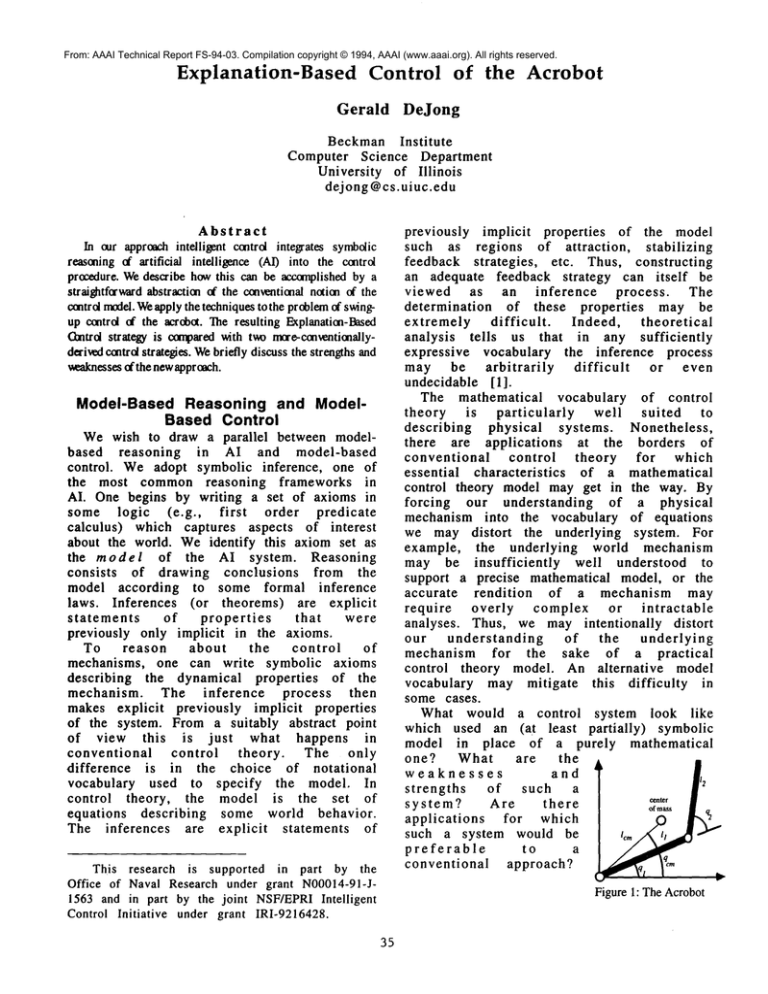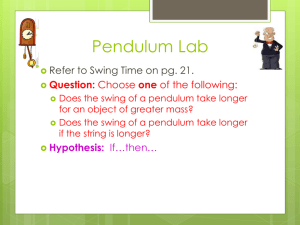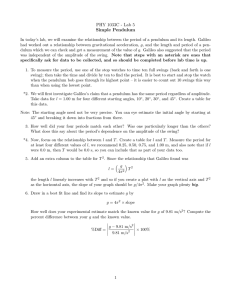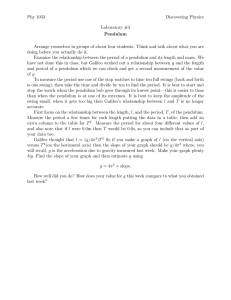
From: AAAI Technical Report FS-94-03. Compilation copyright © 1994, AAAI (www.aaai.org). All rights reserved.
Explanation-Based
Control
Gerald
of the Acrobot
DeJong
Beckman Institute
Computer Science Department
University of Illinois
dejong@cs.uiuc.edu
Abstract
In our approachintelligent contrd integrates symbolic
reasoningof artificial intelligence (AI) into the control
prcr.edur¢. Wedescribe howthis can be acc.~iished by a
straightforwardabstraction of the conventionalnotion of the
central model.Weapplythe techniquesto the problemof swingup contrd of the acrobot. "lhe resulting Explanation-Based
Gantrdstrategy is comparedwith two mare-con~ealtionallyderivedcontrdstrategies. Webriefly discussthe strengthsand
weaknesses
of the newappr oach.
Model-Based Reasoning and ModelBased Control
We wish to draw a parallel
between modelbased reasoning
in AI and model-based
control.
We adopt symbolic inference,
one of
the most common reasoning
frameworks
in
AI. One begins by writing a set of axioms in
some logic
(e.g.,
first
order predicate
calculus)
which captures aspects of interest
about the world. We identify this axiom set as
the model of the AI system.
Reasoning
consists
of drawing conclusions
from the
model according
to some formal inference
laws. Inferences
(or theorems) are explicit
statements
of properties
that
were
previously only implicit in the axioms.
about
the
control
of
To reason
mechanisms, one can write symbolic axioms
describing
the dynamical properties
of the
mechanism.
The inference
process
then
makes explicit previously implicit properties
of the system. From a suitably abstract point
of view this
is just
what happens
in
conventional
control
theory.
The only
difference
is in the choice of notational
vocabulary
used to specify
the model. In
control theory, the
model is the set of
equations describing
some world behavior.
explicit
statements
of
The inferences
are
previously
implicit
properties
of the model
such as regions of attraction,
stabilizing
feedback strategies,
etc. Thus, constructing
an adequate feedback strategy
can itself
be
viewed
as an inference
process.
The
determination
of these properties
may be
extremely
difficult.
Indeed, theoretical
analysis
tells
us that in any sufficiently
expressive
vocabulary the inference
process
may be arbitrarily
difficult
or even
undecidable [1].
The mathematical
vocabulary
of control
theory
is particularly
well suited
to
describing
physical
systems.
Nonetheless,
there are applications
at the borders
of
conventional
control
theory
for which
essential characteristics
of a mathematical
control theory model may get in the way. By
forcing
our understanding
of a physical
mechanism into the vocabulary of equations
we may distort
the underlying
system. For
example,
the underlying
world mechanism
may be insufficiently
well understood
to
support a precise mathematical model, or the
accurate
rendition
of a mechanism
may
require
overly
complex or intractable
analyses. Thus, we may intentionally
distort
our understanding
of the underlying
mechanism for the
sake of a practical
control theory model. An alternative
model
vocabulary
may mitigate
this difficulty
in
some cases.
What would a control
system look like
which used an (at least
partially)
symbolic
model in place of a purely
mathematical
one?
What
are
the
wass aa
T
strengths
of
such
a
system?
Are
there
applications
for which
such a system would be
preferable
to
a
conventional
approach?
This research is supported in part by the
Office of Naval Research under grant N00014-91-J1563 and in part by the joint NSF/EPRIIntelligent
Control Initiative under grant IRI-9216428.
eeAlter
°f,~s
t~
ll//~~
/
.’~
~/%
Figure 1: TheAcrobot
35
The Acrobot
We have been investigating
a two-link
underactuated
robot (the acrobot, see Figure
1). The acrobot model that we use is a twolink planar arm. Link 1 is of length 1I, mass
m l, and center of mass lcl; similarly for link
2. Joint 2, the elbow joint between link 1 and
link 2, is actuated but joint 1, at the shoulder,
is not. The equations of motion of the system
are [2]:
+ ¢, = 0 (1)
d,2/j, + + th + = T (2)
where
a. = + +l;22+ 2l, lc2 cos(q2))+ Z, +
dl2 = nh(l~2 +/ale2 cos(q2))
h~ = -m2/~lc2sin(q 2)q~ - 2m2l~1~22)02q~
sin(q
lh = m2lil~2sin( q2)ilZl
~ = (mal~l + rrh/~ )gc°s(ql) rt hl~2gc°s(qi + q2
¢2 = n’hlc2g cos(qj + q2)
Some aspects
of the acrobot system are
well understood.
Balancing an acrobot-like
system (at ql=lt/2,
q2=0), for example,
studied
in most graduate
control
theory
courses.
Other aspects
involve
recent
research. For example, a 1992 dissertation
on
non-linear
control describes how to balance
along the unstable manifold [3]. Still other
aspects of the system are difficult
to pose in
the traditional
control theoretic
framework
of regulation or tracking.
One less-well-understood
problem is the
so-called
swing-up control of the acrobot.
This problem requires that joint 2 be driven
in such a way so as to excite oscillation
of
joint I. This increases
its amplitude so that
the arm’s center
of
mass is eventually
directly above the joint 1 pivot.
The Control Strategies
We evaluated
through
simulation
three
control strategies
which solve the swing-up
problem.
One strategy
(called
EBC for
Explanation-Based
Control)
is derived
automatically
from a symbolic AI model. All
three strategies
are related
to integrator
backstepping
[4]. This allows the swing-up
controller to formulate a trajectory
for q2. A
simple PD-controller
computes the torque to
track the desired q2 trajectory.
36
The first
strategy
is called
"heuristic
control" (or HC). The basic idea is to drive the
second
link
between
two fixed
values
a
q2 =-I-o~ when ql approaches 0. Like a child
on a swing this injects
energy "in phase"
with the motion of link 1.
The second strategy
(ATAN) smoothes the
trajectory
using q~ =/q arctan(~qz).
This
strategy
is not heuristic;
a rigorous
justification
of its swing-up behavior can be
derived. Details are given in [5].
The third strategy
is explanation-based
control
[6-8]
and is derived
from
explanation-based
learning (EBL) [9, 10]. The
AI system is given three
inputs:
1) an
axiomatization of the world, 2) a goal, and 3)
the trace of a successful solution.
The model
is a set of logic statements
specifying
the
world’s underlying causal relationships.
In
our system these axioms are qualitative
descriptions
of world processes
together
with rules about how quantities
and time
intervals
interact.
For the solution,
the
system was given a trace of the HC strategy.
The system’s
inference
task in EBL is to
"explain"
how the goal was achieved by the
example control input. It must justify,
using
its model of the world, how the actions
observed in the example interact
with the
initial
state to achieve the goal. This results
in a causal account tying the achieved goal
through the model’s causal
axioms to the
control actions and the acrobot’s initial state.
The strategy
is quantified
by calibrating
qualitatively
constrained
functions
using
sensed values of the world’s quantities.
Data from the Strategies
A parameterized
simulator was constructed
for
the acrobot
to allow
empirical
comparison of the three control strategies
under different
conditions.
The simulator is
derived
directly
from equations
(1)-(2)
above except that the angles ql and qcm are
measured from vertically
down so that the
goal is to achieve qcm = g.
In Experiment
1, the three
control
strategies
were applied
to a particular
configuration
of the acrobot.
The maximum
rate c~2 and the maximum allowed deflection
of q2 were set to the values exhibited by the
tuned ATANstrategy.
The friction
model was
purely viscous with an amount which bled
off about half of the energy in one full
pendulum cycle. The acrobot was released at
rest with an initial
qt deflection
of one
radian. The results are given in Figure 2:
Control
Strategy
HC
ATAN
EBC
Figure
Time to
Pendulum
Control
Swing Up
Swings
Actions
1008
6
3.5
593
2
2 q2 cycles
319
1.5
3
2:
Swing-Up Comparison
of
Experiment
1
All three control
strategies
were able to
achieve the goal, even under the condition
of significant
unmodeled friction.
The ATAN
strategy was more time-efficient
than the HC
strategy. It was also the most power-efficient
of the three.
The EBC strategy,
derived
automatically
from the HC strategy,
exhibited
the greatest time- and energy-efficiency.
The traces produced by the HC strategy
is
shown in Figure 3. HC achieved the goal of
swinging the center of mass of the acrobot
above the ql pivot point at time tick 1008.
This point is marked in the figure
by an
abrupt jump in qcm from-~ to x. This jump
does not result
from a drastic
acrobot
movement but only from the normalization
of angles which are adjusted to fall in the
interval
g to-g.
Achievement of the goal
occurs
after three full pendulum swings
encompassing six control actions.
.
Figure 3: HC Quantity
Profile
The ATANstrategy
achieved the goal much
earlier
at time tick 593. Figure 4 shows the
profile
of quantities
during the ATANswingup procedure. The goal was reached after two
and one half pendulum swings in which q2
was swung between its extreme angles four
and one half times.
37
Figure
4:
ATAN Quantity
Profile
The EBC strategy,
though derived from the
HC strategy
via explanation-based
learning,
exhibited the fastest
goal achievement time.
As shown in Figure 5, EBC achieved the goal
at time tick 319. The goal was achieved in one
and a half pendulum swings encompassing
three control actions.
Figure
5: EBC Quantity
Profile
Experiment 2 investigated
robustness
of
the control solutions
to increased friction.
The initial
state and the strategies
were the
same as in Experiment 1. Each strategy
was
tested at 80 progressively
higher levels of
viscous
damping.
The same damping was
applied to both acrobot joints. At the highest
damping rate
a free
swinging
pendulum
with joint 2 locked loses 87% of its energy
through joint 1 during a single swing cycle.
None of the strategies
were able to swing up
under the maximum damping
the acrobot
conditions.
As can be seen in Figure 6 all three
strategies
performed quite well with little
friction.
All exhibit precipitously
degraded
performance
at some level
of friction.
However, the EBC strategy
outperformed the
other two at all friction levels.
It is interesting
to note the sawtooth
behavior of all three strategies.
Periodically
the performance
decreased
sharply
with
increased
friction
and then, surprisingly,
performance improved for a brief interval
as friction
increased.
The time to swing up
the aerobot can be less at higher friction
levels than at lower ones. Examination of the
captured data traces revealed that the time
efficiency
of a pumping action depends in
part on the period of the acrobot’s swing. In
all three strategies
joint 1 and joint 2 are
driven well
into non-linear
ranges. Since
the period
of the acrobot
changes
dramatically
as it is swung up, a slight
increase
in
friction
can significantly
change
the
acrobot
swing periods
encountered
later
in
the swing-up
procedure. This change in period can result
in more time-efficient
later pumping actions
which can more than make up for the loss of
energy to increased friction.
due to gravity.
The Swing-Down-Left process
states that if at any time point t~c m is zero (the
angle from the shoulder to the arm’s center
of mass is even momentarily
constant)
and
and
-~
due
to
qc,~ is negative (between
angle normalization),
then
for the time
interval
that qon remains
negative,
the
explanation
generator may conclude that qcm
and qcm are both increasing.
In other words,
it is reasonable to believe that the acrobot
will be rotating
counterclockwise
with
increasing angular velocity.
Note that as the
counterclockwise
motion
continues,
eventually
the maintenance
preconditions
(q~m < 0) will be violated
terminating
the
Swing-Down-Left
processes.
The Swing-UpRight conditions
are met as the Swing-DownLeft process terminates. It persists until q~m
becomes zero (the counterclockwise
motion
of the pendulum ceases).
Four processes
describe
the natural
swinging
which can be up or down and on
the right or left side of the pivot.
Two
"controllable"
processes are concerned with
the rotation of q2, one for clockwise rotation
and the other for counterclockwise
rotation.
These are activated only by the controller.
The remaining
four processes
describe
how the effective
length of the pendulum
arm (from the shoulder pivot to the system’s
center of mass) changes the relations
among
other quantities.
It is instructive
to describe
one of
these.
The process
Shorten-CCW
includes axioms for the condition that the
effective pendulum arm is becoming shorter
by a counterclockwise
rotation
of q2. It is
The EBC Approach
We now describe
the EBC approach
in
greater detail.
The symbolic world model
consists of ten processes and eight inference
rules. Processes express the behavior of the
acrobot
while inference
rules
capture
universal
regularities
among quantities.
Both employ qualitative
representations
[11,
12].
Each process is composed of preconditions
and a body. During time intervals
in which
the preconditions
hold, the explanation
generator
may draw upon the qualitative
description
axioms in the body. For example,
the process Swing-Down-Left describes
the
qualitative
behavior
while the acrobot is
falling on the left side of the shoulder pivot
3°
I
2500
2000
!
,"%’
1500
V-
lOOOT
~ ~-~ j/
j~
500
_______--_/._
.... ,-. .........
T,..~,.’~’_
__--_
_.
II IIII
...... I’I II "I"
II ’:I’"
I III
:If III ..............................
IIIIII
IIIIII
IIIIII
IIIIII
WO
~
0
0
(5
...
’ ""
III
’-"
"" ""
........
’,: IIIIII
............
IIIIII
:IIIII..........
IIIIII
CO
0
0
~"
0
0
If)
0
0
~
0
0
(0
0
0
I~,
0
0
o
o
c~
o
o
o
Friction
Figure 6: PumpingEffectiveness
38
EBC
acrobot, the system is told to maximize the
rate
of
energy
pumping.
The system
identifies
those portions
of the explanation
in which the rate of change of energy is
justified
to be positive and those portions in
which it is justified
to be negative.
The
system modifies the control actions of these
intervals
to maximize the energy pumping
performance according to the explanation.
Four changes are made to the HC strategy.
First, the control choice for q2 is selected to
be the extreme value that the robot system
can support.
This is because the rate of
change of energy is believed to be positive
and qualitatively
proportional
to
during
any shortening
of the effective
pendulum
length. Second, the final angle for q2 during
shortening
is chosen to be the maximum
deflection
possible.
The energy pumped into
the system increases as the time interval
of
pumping increases,
at the maximum bending
rate.
The time duration
increases
as the
bending motion has farther to go. Third, the
bending control action is scheduled to occur
during
the interval
of maximum angular
velocity.
During lengthening
or shortening,
the rate of change of energy is qualitatively
proportional to
This quantity increases
during swing down motions and decreases
during swing up motions.
Thus, the system
schedules the center of the bending interval
to coincide
with the transition
from swing
down to swing up. Fourth, the middle of the
straightening
control
action (the second
half of the original
HC action in which the
length of the effective
pendulum increases)
is scheduled to occur at the boundary from
swing
up to swing
down.
During
lengthening,
the rate of change of energy is
negative.
The rate
of energy
loss
is
qualitatively
proportional
to the angular
speed
of the arm. The angular
speed
decreases
during swing ups and increases
during swing downs. Thus, the angular speed
is at a minimum at the time point as a swing
up ceases and a swing down commences.
The resultant
EBC strategy
contains twice
as many action conditions as the HC strategy
and these are scheduled
quite differently
from the observed HC strategy.
The system
constructs
explicit
quantitative
estimators
for derived quantities
such as the expected
duration
of a swing-down
event.
The
estimators
are constructed
by spline
interpolation.
The symbolic
explanation
active whenever q2 is both increasing
and
greater than zero. The body of the process
includes
two
qualitative
proportionality
statements. The first says that the time rate
of change of energy, /~, is qualitatively
proportional to q2. The statement says that
while the process is active,
an increase
(alternatively
a decrease)
in /~ may
explained
by an increase
(alternatively
decrease) in t~2. In other words, the faster
the arm is pulled close to the shoulder pivot,
the faster
energy flows into the pendulum
system. The second statement in the body of
Shorten-CCW expresses a similar qualitative
proportionality
from /~ to the absolute value
Iq=l
of q..
Inference rules encode information
to the
inference
system about how quantities
and
their changes relate in general.
Unlike the
processes,
these do not reflect
information
specific
to the aerobot.
For example, one
inference rule states
that quantity,
x, may
have a value,
v, on an interval,
io, if x is
increasing on some interval,
il, and that x
was less than v on an interval,
i2, and that
interval io overlaps il, il overlaps i2, and i2
is before
io. In words, one way that
a
quantity might achieve a particular
value is
to start
out less than that value and be
increasing.
Axioms from the processes
and inference
rules are chained together
to explain the
observed example behavior.
One interesting
feature of the explanation is that the single
HC action taken during each half-swing
of
the pendulum is seen as achieving
two
conceptually different
effects,
one following
the other. The first half of the control action
changes q2 from bent to straight
and is seen
as conceptually
lengthening
the effective
pendulum
arm (the
distance
from the
shoulder
pivot to the system’s
center
of
mass). The second half of each action is seen
as conceptually
shortening
the pendulum
arm by changing q2 from straight
to bent.
After
constructing
the
symbolic
explanation
for the goal achievement,
the
EBL system generalizes
the control actions
into
a decision
procedure.
With the
generalized
explanation
in hand, the system
can automatically
qualitatively
optimize
desired
solution
characteristics.
Such
modifications
are, of course, limited by the
scope of the explanation.
In the case of the
Iq-I
39
specifies
Numeric
behavior
points.
the independent
variables.
observations
of the
mechanisms
in the world supply the spline knot
Conclusions
Employing a symbolic
model
yields a
rather different
class of control
strategies.
For some
applications
they
may be
preferable
to
conventionally-derived
strategies.
However, there are also distinct
disadvantages.
Additionally,
the control
engineer
must be prepared
to shoulder
somewhat different
responsibilities
than
arise in constructing
a conventional control
strategy.
First and foremost,
the EBC approach
requires a symbolic qualitative
model. This
can be a difficult
task. Another requirement
is the construction
of explicit quantitative
estimators.
These are calibrated
from
observations
of the world and so require an
adaptive phase. A third disadvantage
is the
need for a positive
example. The system’s
explanation
process is focused by captured
data of the goal being achieved. Thus, some
existing
mechanism - a person, or as in our
experiments, another control system
must
supply at least one positive example. This
requirement applies
to all but the
most
trivial
mechanisms. It stems from the fact
that the space of well-formed explanations,
even for very small symbolic models, can be
prohibitively
large. Searching such a space
without guidance is simply too expensive.
On the positive
side,
the behavior
exhibited by an EBCstrategy is not limited by
the quality
or generality
of the observed
solution.
Knowledge of a single
action
sequence that achieves an instance
of the
goal in
a highly
non-optimal
way may
suffice.
Furthermore,
the vocabulary
of
symbolic
axioms is strictly
more general
than the vocabulary of equations,
providing
a richer
space of possible
models.
For
mechanisms that are difficult
to capture
conventionally,
we may be able to find a
model that better
fits
our knowledge.
We
believe
the
important
advantage,
most
however, will prove to be the blending
of
planning and control that the EBC approach
affords.
References
1. Genesereth, M.R. and N.J. Nilsson,
Foundations of Artificial
Intelligence.
Palo Alto: Morgan Kaufmann.
Logical
1986,
2. Spong, M.W. and M. Vidyasagar,
Robot
Dynamics and Control. 1989, New York: John
Wiley & Sons.
3. Bortoff,
S., Pseudolinearization
of the
AcrObot Using Spline Functions. 1992, Ph.D.
Thesis,
University
of Illinois
at UrbanaChampaign, Dept of Electrical
and Computer
Engineering.
4. Kokotovic,
P.V.,
M. Krstic,
and I.
Kanellakopoulos.
Backstepping to Passivity:
Recursive
Design of Adaptive
Systems.
in
IEEE Conference
on Decision
and Control.
1992, Tuscon, AZ: p. 3276-3280.
5. Spong,
M. Swing Up Control
of the
Acrobot. in IEEE International
Conference
on Robotics and Automation. 1994, San Diego.
6. DeJong, G.F. Explanation-Based
Control:
an Approach
to Reactive
Planning
in
Continuous
Domains.
in lnnoavative
Approaches
to
Planning,
Scheduling
and
Control. 1990, San Diego, CA: p. 325-336.
7. DeJong,
G.F.
A Machine
Learning
Approach to Intelligent
Adaptive Control. in
29th IEEE
Conference
on Decision
and
Control. 1990, p. 1513-1518.
8. DeJong,
G.F.,
Learning
to Plan in
Continuous
Domains.
Artificial Intelligence,
1994. 64(1): p. 71-141.
9. Mitchell,
T., R. Keller,
and S. KedarCabelli, Explanation-Based
Generalization:
A
Unifying
View. Machine Learning,
1986.
1(1): p. 47-80.
10. DeJong,
G.F.
and R.J.
Mooney,
Explanation-Based
Learning: An Alternative
View. Machine Learning, 1986. 1(2): p. 145176.
11. Forbus, K.., Qualitative
Process Theory.
Artificial
Intelligence, 1984. 24: p. 85-168.
12. Kuipers, B.J., Qualitative
Simulation.
Artificial
Intelligence, 1986. 29: p. 289-338.
4O







